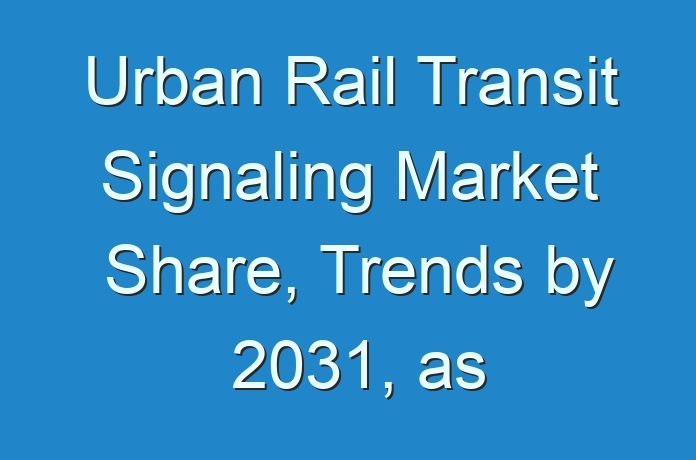
Urban Rail Transit Signaling Market: Introduction
The signaling system provide the means to efficiently control train services, ensuring safety in train movements. It assists in optimization of metro infrastructure investment and running of efficient train services on the network.
Key Drivers of Urban Rail Transit Signaling Market
- Presently, national urban public transport authorities and PPP policymakers of several countries, especially developing countries in the world, are trying to develop comprehensive PPP policy systems for urban public transport, while the World Bank and the Asia Development Bank have also been actively advocating the construction of public transportation such as urban rail transit systems. This standard is estimated to provide the policy framework and PPP model principles applied in the urban rail transit sector, in line with the requirements of international organizations and governments. The standard would try to standardize the operation of urban rail transit PPP projects, reduce transaction costs, and attract more private capital involvement in the construction of urban rail transit projects. Therefore, this scenario is likely to boost new urban rail transit project developments in the coming years; subsequently, drive the demand for urban rail transit systems and consequently, propel the urban rail transit signaling market.
Want to know the obstructions to your company’s growth in future? Request a brochure @ https://www.transparencymarketresearch.com/sample/sample.php?flag=S&rep_id=81741
- In the signaling segment, future investments in Western Europe to upgrade and modernize signaling systems through the European Train Control System (ETCS) national implementation plans across different countries are estimated to propel the segment and boost the overall rail market
Challenges in Urban Rail Transit Signaling Market
- A significant proportion of urban rail transit business, at any given period, relies on government agencies and other public institutions, which have historically represented the vast majority of the value of the orders that urban rail transit project handling company book annually. The amount public institutions are able to invest and spend depends on complex political and economic factors, which could vary from one fiscal year to the next. Economic slowdown and public budgetary restrictions can cause a decrease in infrastructure investments, delays in placing orders, and delays in execution of contracts or payments, as well as a decrease in fiscal and other incentive-based measures to impact research and development expenses of the companies. Therefore, these factors hamper the urban rail transit signaling market.
Opportunities in Urban Rail Transit Signaling Market
- The rail industry is expecting positive change in the next few years due to the digital industry revolution, especially in signaling and maintenance services. Using disruptive technologies, such as Internet of things, automated trains, and big data analytics, new business models are expected to evolve especially toward more service-oriented approach. Consequently, original equipment manufacturers are closely monitoring the eco-systems to meet their future needs.
Asia Pacific to Dominate Urban Rail Transit Signaling Market
- Based on region, the global urban rail transit signaling market has been segregated into North America, Asia Pacific, Europe, Latin America, and Middle East & Africa
- Asia Pacific is projected to be highly lucrative region of the global urban rail transit market during the forecast period. This is primarily owing to high urban transport infrastructure project investments by rapidly developing countries in the region. Governments in the region are committed to promoting public transport systems. Public transportation infrastructure in India needs high levels of investment and massive upgrading to spur a modal shift from private vehicles. It is estimated that over 50% people in India would be residing in urban areas by 2050. Metro rail is seen as a necessary solution for developing mass rapid transit systems in India’s large cities. Therefore, these prospects offer significant opportunity for the urban rail transit signaling market in the region.
Looking for exclusive market insights from business experts? Request a Custom Report
Key Players Operating in Urban Rail Transit Signaling Market
The global urban rail transit signaling market is moderately consolidated. A few of the key players operating in the global urban rail transit signaling market are:
- Alstrom
- Siemens
- MER MEC S.p.A
- Hitachi
- CRRC Corp Ltd
- LARSEN & TOUBRO LIMITED
- Kawasaki Heavy industries
- Mitsubishi Electric
- General Electric
- Wabtec Corporation
Global Urban Rail Transit Signaling Market: Research Scope
Global Urban Rail Transit Signaling Market, by Component
- Continuous Automatic Train Control
- communications-based train control (CBTC)
- Interlocking System
- Train Depot Signaling
- Others
Read Our Trending Press Release Below: https://www.prnewswire.com/news-releases/contract-packaging-market-shifts-gear-towards-progress-with-a-7-0-cagr-and-rise-in-e-commerce-notes-tmr-301008343.html





